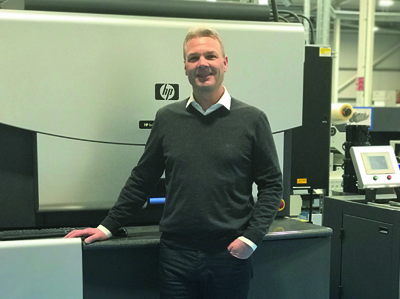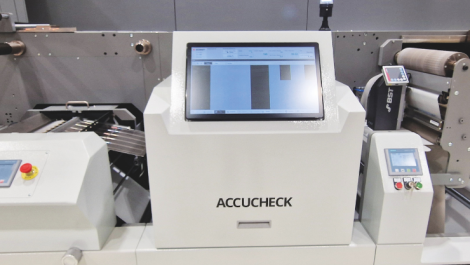Paul Roscoe
Interview with Paul Roscoe, managing director of Berkshire Labels. By Des King.
Originally set up in 1984, and operating out of a garage with only a hot foil printer, Berkshire Labels is today an award-winning £10 million turnover business driven by an equal complement of HP Indigo WS6800 digital presses and UV flexo machines. Sales have doubled in the eight years in which digital replaced its letterpress division; an impressive track record that led to the company being accorded HP’s Highest Year on Year Growth award last year.
‘Everyone who has ever operated a rotary letterpress or a web-fed flexo press will have this habit of nodding their head from left to right as it brings things into focus whilst running,’ recalled Berkshire Labels’ managing director Paul Roscoe of his early days with the family-owned business, which was set up by his father, and whose development he’s been very much a part of man and boy for the past 32 years.
Whilst Mr Roscoe and his team are still prone to nodding left and right, nowadays it is to indicate which production capability is best suited for a particular job: short to medium run lengths to digital; medium to long to flexo. ‘There’d been consideration over the years as to whether a particular job was better for flexo or for digital,’ he noted. ‘Where we wanted to get to and have now done is for the label not to dictate the process but rather the quantities.’
When and why did you extend into digital print?
We first started looking at digital in the mid 90s when Indigo brought out the first Omnius press. We like to invest in new technology and had been planning to wind down our existing letterpress operation. Whilst we liked what we saw it wasn’t right for us at the time; mainly down to volume and cost. The game-changer was when the series 3 came out. We bought our first 6000 series press in 2010 having seen one working in a European label factory. We were 100% certain that this was the perfect timing for us to jump into the digital arena, the moment we saw what it offered in terms of stability, quality, speed and everything else.
What were the main challenges you had to address?
When we installed that original Indigo WS6000, it led to a ‘very interesting’ first year; not least in taking the time to educate and encourage our customers to utilise all of the benefits. You learn to be successful very quickly. Having one machine is difficult because you want to fill it up for it to be commercially viable and you still want to offer the short lead-times since that was the purpose in installing it in the first place.
Some of the new work we were bringing in had hundreds of different SKUs that had to be put through the MIS at the front end. That took some adjustment and updating to handle those orders. It could take a day between customer approval and the job going on-press; now as soon as our jobs get approved by the customer they are released straight to the Indigo. We’ve gone from a worst case of 24 hours to 24 seconds.
And what have been the main gains?
Our whole business has completely changed in the last eight years. Digital has brought in hundreds and hundreds of new customers. Turnover has doubled to £10 million.
I remember in the early days being sat in front of a customer and they had all these different SKUs: maybe a couple of hundred different sorts, all full colour, all backed with white, etc. A year before I would have been asking them about bleeds on the white, spot colours to separate out, vignettes blending into each other and so forth. Prior to digital that wouldn’t have been possible with all that origination; likewise the customer only wanting 1000 of each. They’d have had to dumb down the design or at least standardise it across the range and just gone for one colour to change. Instead, they could go for a full floral pattern change on every label. That was a defining moment for me when I realised I could say to the customer: ‘You can have what you want; it’s absolutely fine.’

Digitally printed shrink sleeves for Firefly
How has customer awareness to digital developed over the years?
We were saying, ‘Broaden your horizons; you need to think in a different manner.’ We wanted customers to not narrow their choices, not narrow their lines but to change their designs on every one that came through. We wanted them to have signatures, we wanted them to add versions, to add numbers. We encouraged them to reduce their order volumes: not to ask for 100,000 off and be left with lots of unused labels in stock, but order as many or as few as they wanted. That was all very new to them back then.
We had customers questioning whether they could tell the difference in quality. We were able to show them that not only was it not possible to tell the difference, but that in some cases the quality achieved with digital was far better. We spent a good year convincing some customers, and then it just fell into the mainstream. Nowadays they don’t even think about any difference in how a label is printed; we hardly do ourselves.
How has digital helped you and them to develop your businesses?
Two years ago we put in a massive amount of time and effort to create a digital flexo environment. We took everything that we’d learnt on the Indigos for six years and applied all of that methodology and thought process to flexo. We introduced a full closed loop colour management system throughout the entire company. We upgraded all of our inks to ISO for four colours. We use X-Rite technology to scan in all of our spot colours. We installed a brand new flexo press: twin servo-driven with all-electronic registers. Basically, we wanted a workflow that went left or right: short medium; medium long.
We have many jobs that start life on the 6800, but as they’re all profiled and as the run lengths increase switch over to flexo. The customer doesn’t know, or else can’t tell the difference. We wanted the perfect HD dot: printed perfect shape and size, and in perfect register. That’s all we do with the Indigo, so that’s what we set out to do with the next generation of flexo.
It’s given customers a lot more choice in terms of high-quality labelling, and allowed them to be a lot more innovative and creative as well. Prior to digital, certain lower volume items would have been restricted to maybe two spot colours or something. People with short-run labels would not have gone for the full extent of full colour origination. If you’ve got multiple SKUs and short runs you wouldn’t have paid for all those plates.
As well as more choice, quality on the retail shelf is much higher too with smaller brands. Everyone goes for full colour design. A design brief used to be dependent on volume and run length; that would immediately limit your choice of production. Now it doesn’t matter – you can have a creative label that’s identical for the start-up small runs as it would be for the mainstream long runs.
Looking back is there anything you wish you’d done differently?
No not really. With the benefit of hindsight would I have automated the workflow sooner? Possibly – but I don’t think you put the workflow in before you buy the press. I’m very pleased with the development and the progress we’ve all made.
What advice would you give to anyone adopting digital now?
I’d probably advise them to clear their diary for the next 12 months; throw themselves in at the deep end and enjoy the journey! There is more to this than installing the press though. You just have to do digital differently.
How do you see the future for digital print for packaging?
I think digital will continue to develop in all ways possible. We’re part of HP’s beta programme so we get to see some of the new developments coming through, and they’re looking at all areas. The different digital technologies will continue to complement each other in the market place and all get stronger: toner, electrostatic, inkjet. Landa, most definitely; I’m as excited as everyone else about that. If you had to list everything you want: high quality, high speed, low cost, great environmental credentials – who wouldn’t want one of those?
We as a business continue to invest in both digital and conventional. But I don’t really mind what technology we have because we’re customer-focused; we’re here to make sure we deliver a great job to our great customers. I don’t mind what machine that’s off. As long as we have customers that require short, medium and long run lengths then we’ll always run digital and conventional technologies together hand in hand.






